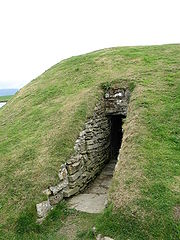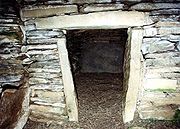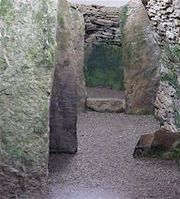
Unstan Chambered Cairn
Encyclopedia

Neolithic
The Neolithic Age, Era, or Period, or New Stone Age, was a period in the development of human technology, beginning about 9500 BC in some parts of the Middle East, and later in other parts of the world. It is traditionally considered as the last part of the Stone Age...
chambered cairn
Chambered cairn
A chambered cairn is a burial monument, usually constructed during the Neolithic, consisting of a cairn of stones inside which a sizeable chamber was constructed. Some chambered cairns are also passage-graves....
located on Mainland, Orkney, Scotland
Scotland
Scotland is a country that is part of the United Kingdom. Occupying the northern third of the island of Great Britain, it shares a border with England to the south and is bounded by the North Sea to the east, the Atlantic Ocean to the north and west, and the North Channel and Irish Sea to the...
. The tomb was built on a promontory that extends into the Loch of Stenness
Loch of Stenness
The Loch of Stenness together with the Loch of Harray are the two largest freshwater lochs of Mainland, Orkney. In Old Norse their names are Steinnesvatn and Heraðvatn...
near the settlement of Howe and the town of Stromness
Stromness
Stromness is the second-biggest town in Orkney, Scotland. It is in the south-west of Mainland Orkney. It is also a parish, with the town of Stromness as its capital.-Etymology:...
. Unstan is notable as an atypical hybrid of the two main types of chambered cairn
Chambered cairn
A chambered cairn is a burial monument, usually constructed during the Neolithic, consisting of a cairn of stones inside which a sizeable chamber was constructed. Some chambered cairns are also passage-graves....
found on Orkney, and as the location of the first discovery of a type of pottery that now bears the name of the tomb.
The site is in the care of Historic Scotland
Historic Scotland
Historic Scotland is an executive agency of the Scottish Government, responsible for historic monuments in Scotland.-Role:As its website states:...
.
Discussion
The tomb is a particularly well preserved, and somewhat unusual, example of the Orkney-CromartyCromarty
The Royal Burgh of Cromarty is a burgh in Ross and Cromarty, Highland, Scotland.-History:It was previously the county town of the former county of Cromartyshire...
type of chambered cairn
Chambered cairn
A chambered cairn is a burial monument, usually constructed during the Neolithic, consisting of a cairn of stones inside which a sizeable chamber was constructed. Some chambered cairns are also passage-graves....
. Tombs of this type are often referred to as "stalled" cairns due to their distinctive internal structure. Stalled cairns have a central passageway flanked by a series of paired transverse stones that separate the side spaces into compartments that reminded early investigators of horse stalls. The earliest versions of this tomb type are found in Caithness
Caithness
Caithness is a registration county, lieutenancy area and historic local government area of Scotland. The name was used also for the earldom of Caithness and the Caithness constituency of the Parliament of the United Kingdom . Boundaries are not identical in all contexts, but the Caithness area is...
, they typically consist of no more than four stalled compartments. In Orkney, the tombs became increasingly elaborate; the number of compartments reached a maximum of fourteen at the Knowe of Ramsay on Rousay
Rousay
Rousay is a small, hilly island about north of Orkney's Mainland, off the north coast of Scotland, and has been nicknamed "the Egypt of the north", due to its tremendous archaeological diversity and importance....
. Unstan is a more modest example of the form with five chambers flanking a passageway 6.4 metres (21 ft) in length. Like most tombs in Orkney, the original roof is gone, replaced by a modern concrete dome that protects the site. The remaining walls rise to a height of almost 2 metres (6.6 ft), and consist primarily of thin stacked slabs of local flagstone
Flagstone
Flagstone, is a generic flat stone, usually used for paving slabs or walkways, patios, fences and roofing. It may be used for memorials, headstones, facades and other constructions. The name derives from Middle English flagge meaning turf, perhaps from Old Norse flaga meaning slab.Flagstone is a...
that come from the Devonian
Devonian
The Devonian is a geologic period and system of the Paleozoic Era spanning from the end of the Silurian Period, about 416.0 ± 2.8 Mya , to the beginning of the Carboniferous Period, about 359.2 ± 2.5 Mya...
Old Red Sandstone
Old Red Sandstone
The Old Red Sandstone is a British rock formation of considerable importance to early paleontology. For convenience the short version of the term, 'ORS' is often used in literature on the subject.-Sedimentology:...
.
Unstan is an atypical example of the Orkney–Cromarty
Cromarty
The Royal Burgh of Cromarty is a burgh in Ross and Cromarty, Highland, Scotland.-History:It was previously the county town of the former county of Cromartyshire...
chambered cairn
Chambered cairn
A chambered cairn is a burial monument, usually constructed during the Neolithic, consisting of a cairn of stones inside which a sizeable chamber was constructed. Some chambered cairns are also passage-graves....
in several respects. First, the barrow
Tumulus
A tumulus is a mound of earth and stones raised over a grave or graves. Tumuli are also known as barrows, burial mounds, Hügelgrab or kurgans, and can be found throughout much of the world. A tumulus composed largely or entirely of stones is usually referred to as a cairn...
that covered the tomb is a circle 13 metres (42.7 ft) in diameter, rather than the usual oblong or rectangular form. Second, the barrow
Tumulus
A tumulus is a mound of earth and stones raised over a grave or graves. Tumuli are also known as barrows, burial mounds, Hügelgrab or kurgans, and can be found throughout much of the world. A tumulus composed largely or entirely of stones is usually referred to as a cairn...
is round because the tomb contains a side chamber, a feature more common in the Maeshowe
Maeshowe
Maeshowe is a Neolithic chambered cairn and passage grave situated on Mainland, Orkney, Scotland. The monuments around Maeshowe, including Skara Brae, were designated a UNESCO World Heritage Site in 1999. It gives its name to the Maeshowe type of chambered cairn, which is limited to Orkney...
-type tombs. Third, the main chamber does not open at the end of the passageway, like typical stalled tombs, but along one long side. Again, this is more characteristic of the Maeshowe
Maeshowe
Maeshowe is a Neolithic chambered cairn and passage grave situated on Mainland, Orkney, Scotland. The monuments around Maeshowe, including Skara Brae, were designated a UNESCO World Heritage Site in 1999. It gives its name to the Maeshowe type of chambered cairn, which is limited to Orkney...
tombs. The barrow
Tumulus
A tumulus is a mound of earth and stones raised over a grave or graves. Tumuli are also known as barrows, burial mounds, Hügelgrab or kurgans, and can be found throughout much of the world. A tumulus composed largely or entirely of stones is usually referred to as a cairn...
is made of two or three concentric rows of stonework.
Evidence from nearby tombs suggests that they, and Unstan, were built sometime between 3400 and 2800 BC.
Unstan is also notable in that the first discovery of a distinctive style of pottery was made here in 1884. These pots are the type examples of what has come to be known as Unstan ware
Unstan ware
Unstan ware is the name used by archaeologists for a type of finely made and decorated Neolithic pottery from the 4th and 3rd millennia BC. Typical are elegant and distinctive shallow bowls with a band of grooved patterning below the rim, using a technique known as "stab-and-drag". A second version...
. Unstan ware
Unstan ware
Unstan ware is the name used by archaeologists for a type of finely made and decorated Neolithic pottery from the 4th and 3rd millennia BC. Typical are elegant and distinctive shallow bowls with a band of grooved patterning below the rim, using a technique known as "stab-and-drag". A second version...
typically consists of elegant shallow bowls with a band of grooved patterning below the rim, created using a technique known as "stab-and-drag". A second version consists of undecorated, round-bottomed bowls. Some of the bowls had bits of volcanic rock included in the clay to make them stronger. After firing, bone tools were used to burnish the surfaces to make them shiny and impermeable. Parts of twenty to thirty bowls were found in the tomb, many of them were Unstan ware
Unstan ware
Unstan ware is the name used by archaeologists for a type of finely made and decorated Neolithic pottery from the 4th and 3rd millennia BC. Typical are elegant and distinctive shallow bowls with a band of grooved patterning below the rim, using a technique known as "stab-and-drag". A second version...
. Most of the bowls were shattered or incomplete; this is common in chambered cairn
Chambered cairn
A chambered cairn is a burial monument, usually constructed during the Neolithic, consisting of a cairn of stones inside which a sizeable chamber was constructed. Some chambered cairns are also passage-graves....
s and suggests that the vessels were intentionally broken for inclusion with the dead. These bowls were not newly created for use in the tomb- they had clearly seen prior use, for example, some of the sherds had impressions of barley grains. A number of fragments were found in a shallow hollow in the clay floor- a pattern seen in other tombs. Several of the reconstructed vessels are in the National Museum of Scotland
National Museum of Scotland
The National Museum of Scotland, Edinburgh, Scotland, was formed in 2006 with the merger of the Museum of Scotland, with collections relating to Scottish antiquities, culture and history, and the Royal Museum next door, with collections covering science and technology, natural history, and world...
.
Human remains were found in Unstan — there were two crouched skeletons in the side cell, several more in the main compartment and a number of bones were scattered throughout the rest of the tomb. Animal bones and charcoal were found as well.
It's possible that Unstan was in use well into the second millennium BC; an arrowhead
Arrowhead
An arrowhead is a tip, usually sharpened, added to an arrow to make it more deadly or to fulfill some special purpose. Historically arrowheads were made of stone and of organic materials; as human civilization progressed other materials were used...
was discovered in the tomb that is characteristic of the Beaker People who lived from the Late Neolithic
Neolithic
The Neolithic Age, Era, or Period, or New Stone Age, was a period in the development of human technology, beginning about 9500 BC in some parts of the Middle East, and later in other parts of the world. It is traditionally considered as the last part of the Stone Age...
into the Bronze Age
Bronze Age
The Bronze Age is a period characterized by the use of copper and its alloy bronze as the chief hard materials in the manufacture of some implements and weapons. Chronologically, it stands between the Stone Age and Iron Age...
.
Toponymy
The second element of the name, stan, or ston, comes from a particularly Orcadian version of the NorseOld Norse
Old Norse is a North Germanic language that was spoken by inhabitants of Scandinavia and inhabitants of their overseas settlements during the Viking Age, until about 1300....
word stadr which means a farm settlement.


See also
- Midhowe Chambered CairnMidhowe Chambered CairnMidhowe is a large Neolithic chambered cairn located on the south shore of the island of Rousay, Orkney, Scotland. The name "Midhowe" comes from the spectacular Bronze Age broch that lies just west of the tomb...
- Unstan wareUnstan wareUnstan ware is the name used by archaeologists for a type of finely made and decorated Neolithic pottery from the 4th and 3rd millennia BC. Typical are elegant and distinctive shallow bowls with a band of grooved patterning below the rim, using a technique known as "stab-and-drag". A second version...
- Ring of BrodgarRing of BrodgarThe Ring of Brodgar is a Neolithic henge and stone circle on the Mainland, the largest island in Orkney, Scotland...
- Standing Stones of Stenness
- MaeshoweMaeshoweMaeshowe is a Neolithic chambered cairn and passage grave situated on Mainland, Orkney, Scotland. The monuments around Maeshowe, including Skara Brae, were designated a UNESCO World Heritage Site in 1999. It gives its name to the Maeshowe type of chambered cairn, which is limited to Orkney...
- Prehistoric OrkneyPrehistoric OrkneyPrehistoric Orkney refers to a period in the human occupation of the Orkney archipelago of Scotland that was the latter part of these islands' prehistory. The period of prehistory prior to occupation by the genus Homo is part of the geology of Scotland...
- Timeline of prehistoric ScotlandTimeline of prehistoric ScotlandThis timeline of prehistoric Scotland is a chronologically ordered list of important archaeological sites in Scotland and of major events affecting Scotland's human inhabitants and culture during the prehistoric period. The period of prehistory prior to occupation by the genus Homo is part of the...

